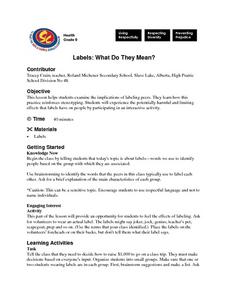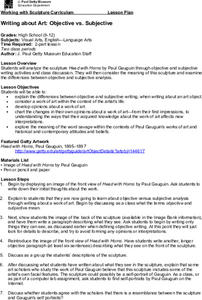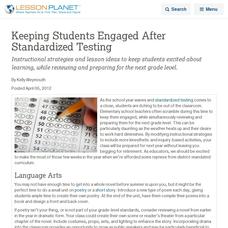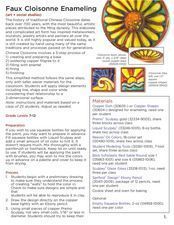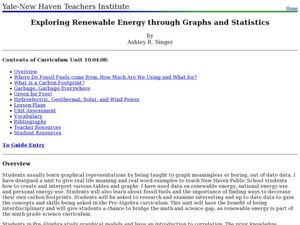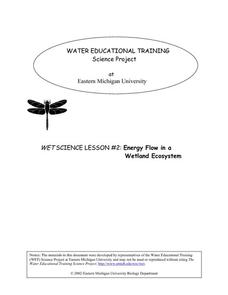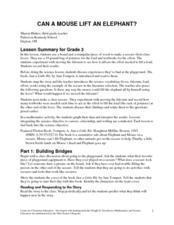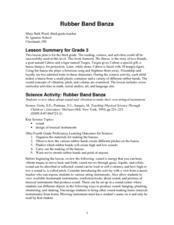ESL Kid Stuff
Past Tense Activities - Irregular Verbs
"What did you do yesterday?" Language learners engage in carefully scaffolded activities that review past tense regular verbs, that introduce new vocabulary words, and that permit practice of using the past tense of irregular verbs.
Curated OER
Move It Line Dance
The upbeat song "I Like to Move It" from the movie Madagascar is just the ticket! Get your younsters up and moving. The basic steps in this dance are the grapevine, side step, squat, back step, jumps, jumping jacks, and marching in...
Curated OER
Putting the Pieces Together
Children explore fractions on a conceptual level by making individual quilt squares. Each student works with small paper swatches to divide them into pieces that represent a given fraction. The class is then separated into groups and...
Curated OER
Trek Across America
Bring a time machine into your classroom with this writing lesson plan, in which young writers project themselves back in time and have a variety of choices from that point forward. They either write a conversation with a historical...
Curated OER
Energy Conservation Games
Middle school physicsl science explorers play a game using dominoes that you have photocopied onto cardstock. Through the game, they familiarize themselves with the conservation of energy and the transformatin from one form to another....
Curated OER
Affix This
Wait, what am I supposed to affix? Explore the concept of roots/affixes with your class. They use discussion questions to discover the meaning and usage of specific roots and affixes. They watch a video explaining Latin and Greek roots...
Southern Nevada Regional Professional Development Program
Pardon Me, Your Modifier is Dangling
Lost! (or misplaced) a modifier. Last seen dangling at the end of a sentence! Reward offered! To underscore the humor, class members are each given a sample sentence to illustrate (A woman passed by, leading a Springer Spaniel, in a long...
Curated OER
Labels: What Do They Mean?
Ninth graders brainstorm words they typically use to label each other, discuss effects of labeling, including reinforcement of stereotypes, and experience potentially harming and limiting effects that labels have by participating in...
Curated OER
Writing About Art: Subjective vs. Objective
Explore objective and subjective writing in this interdisciplinary instructional activity, which brings language arts and visual art together. Middle and high school learners examine the sculpture Head with Horns by Paul Gauguin. They...
Curated OER
No Name Calling Week
The lessons learned during No Name Calling Week can last throughout the year.
Curated OER
The State of "No Child Left Behind"
Your class can read about the changes Obama considered making to Bush's No Child Left Behind Act. After reading the article, pupils answer 13 questions that ask, who, what, when, where, and why.
Curated OER
Reading Strategies for Decoding Tricky Words
Help primary school pupils learn valuable reading strategies. As they choral read a poster or big book, they predict covered words and learn various reading strategies for figuring out an unknown word. This will help them gain an...
Curated OER
Hypothetical Heights
High schoolers participate in an interdisciplinary lesson to discuss improvements that would make them want to return to a previously poor neighborhood. In this civics lesson, students work in a budget to make a plan to better their...
Curated OER
Keeping students engaged after standardized testing
Instructional strategies and lesson ideas to keep students excited about learning, while reviewing and preparing for the next grade level.
American Psychological Association
Counting Fidgets: Teaching the Complexity of Naturalistic Observation
Why do psychologists conduct experiments in controlled laboratory settings? High schoolers gain an understanding of the importance of controls with an activity that involves naturalistic observations with no imposed controls.
Curated OER
Faux Cloisonne Enameling
Middle and high school students engage in enameling and apply design elements. They study the history and tradition of Cloisonne. The history of traditional Chinese Cloisonne dates back over 700 years, with the most beautiful, artistic...
Curated OER
Beary Necessary Rules
Young pupils learn about classroom rules as they also practice active reading strategies and reading comprehension skills. This instructional activity begins with a thorough reading of the story Brown Bear, Brown Bear, What Do You...
Curated OER
Shrinky Dinks® Palettes
Here is a fun and clever lesson for teaching physics classes how to calculate wavelength if given the energy and frequency data. On a worksheet, they compute wavelengths using a table of information that you provide. On a paper palette,...
Curated OER
Exploring Renewable Energy Through Graphs and Statistics
Ninth graders identify different sources of renewable and nonrenewable energy. In this math lesson, learners calculate their own carbon footprint based on the carbon dioxide they create daily. They use statistics to analyze data on power...
Curated OER
Michael Jackson's “Beat It” Dance
Looking for a line dance? Look no further. This dance is performed to Michael Jackson's "Beat It". It is comprised of four eight-counts. The moves consist of walking forward, swinging the hips, doing the grapevine, walking backwards, and...
Curated OER
Youth Art Month Made Simple
Pragmatic projects designed to integrate Youth Art Month with your curriculum.
Eastern Michigan University
Energy Flow in a Wetland Ecosystem
How is energy transferred within an ecosystem? What would happen to a food web if one of the organisms was removed? Elementary or middle school ecologists examine these questions and more in a comprehensive 5E learning cycle lesson....
Curated OER
Can a Mouse Lift an Elephant?
Read Just a Little Bit, by Ann Tompert as an introduction to levers. Discuss playground seesaws and then turn learners loose to experiment with the placement of a fulcrum. Their goal is to determine where to place it in order to lift ten...
Curated OER
Rubber Band Banza
Third graders review ideas about sound and vibration to make their own stringed instrument. They review what a pictograph and bar graph are. Pupils conduct a survey within the classroom to choose the four favorite string instruments and...









